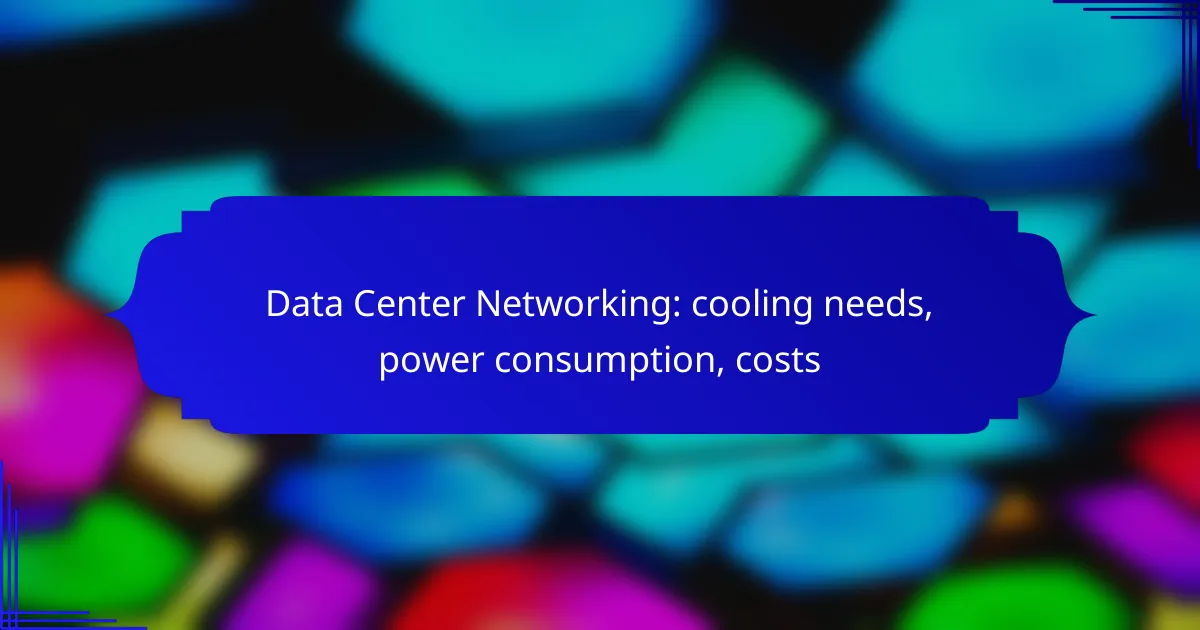Data center networking is a complex interplay of cooling needs, power consumption, and associated costs, all of which are vital for maintaining optimal performance and sustainability. Effective cooling systems are essential to manage heat generated by equipment, while power consumption directly impacts operational efficiency and expenses. Understanding the financial implications of these factors is crucial for effective budgeting and resource allocation in data center management.
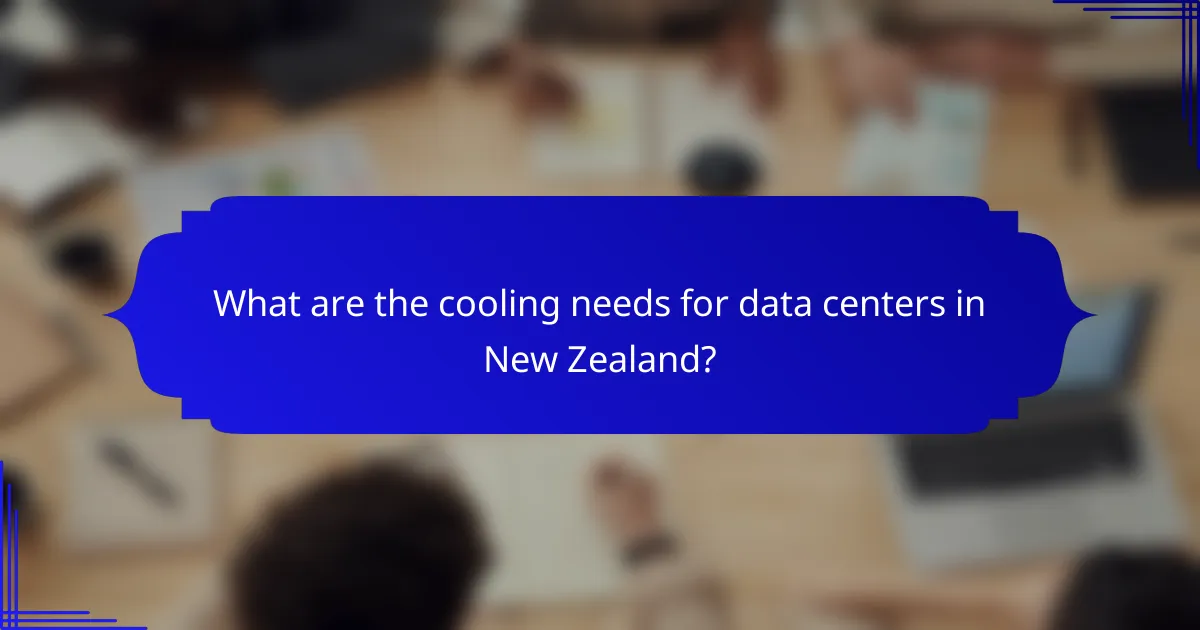
What are the cooling needs for data centers in New Zealand?
Data centers in New Zealand require effective cooling systems to manage heat generated by servers and equipment. Proper cooling not only ensures optimal performance but also prolongs the lifespan of hardware, making it a critical aspect of data center management.
Air cooling systems
Air cooling systems are the most common method for cooling data centers. They typically use a combination of Computer Room Air Conditioning (CRAC) units and raised floors to circulate cool air. These systems can be efficient for smaller data centers but may struggle with larger facilities due to airflow limitations.
In New Zealand, air cooling systems often utilize outside air for free cooling during cooler months, which can significantly reduce energy costs. However, reliance on air cooling can lead to hotspots if not properly managed.
Liquid cooling solutions
Liquid cooling solutions are increasingly popular for their efficiency in managing heat in high-density environments. These systems use water or specialized coolants to absorb heat directly from servers, allowing for higher performance and reduced energy consumption.
In New Zealand, liquid cooling can be particularly advantageous in larger data centers where air cooling may not suffice. However, these systems require careful planning and maintenance to prevent leaks and ensure effective heat exchange.
Environmental control systems
Environmental control systems monitor and manage temperature, humidity, and airflow within data centers. These systems use sensors and automated controls to maintain optimal conditions, which are crucial for preventing equipment failure.
In New Zealand, adhering to environmental standards can help data centers optimize their cooling strategies. Implementing these systems can lead to significant energy savings and improved operational efficiency.
Best practices for cooling efficiency
To enhance cooling efficiency, data centers should implement several best practices. Regular maintenance of cooling equipment, optimizing airflow management, and using hot aisle/cold aisle containment strategies can significantly improve performance.
Additionally, monitoring energy usage and adjusting cooling strategies based on real-time data can lead to better resource allocation. Avoiding overcooling and ensuring proper insulation can also help reduce costs and improve overall efficiency.
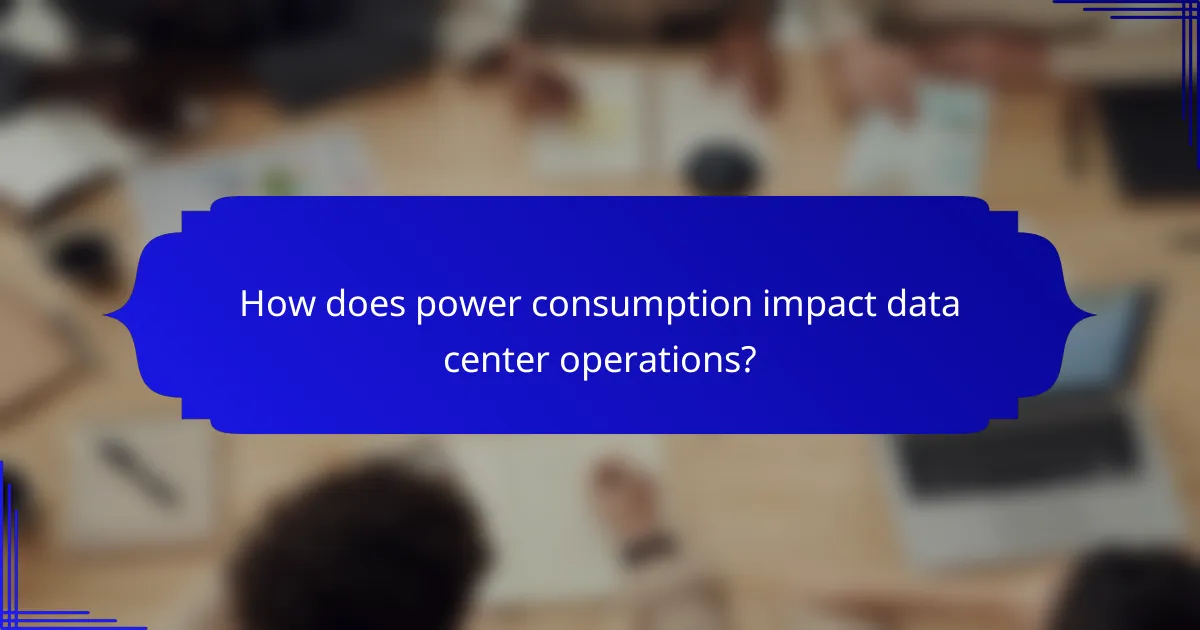
How does power consumption impact data center operations?
Power consumption significantly influences data center operations by affecting efficiency, costs, and environmental impact. High energy usage can lead to increased operational expenses and necessitate more robust cooling solutions, which further complicate management and sustainability efforts.
Power usage effectiveness (PUE)
Power Usage Effectiveness (PUE) is a key metric for assessing data center energy efficiency. It is calculated by dividing the total building energy usage by the energy used by the IT equipment alone. A PUE of 1.0 indicates optimal efficiency, while typical values range from 1.1 to 2.0, with lower values being preferable.
To improve PUE, data centers can implement strategies such as optimizing cooling systems and utilizing energy-efficient hardware. Regular monitoring and adjustments can help maintain a favorable PUE, ultimately reducing energy costs and environmental impact.
Energy-efficient hardware options
Investing in energy-efficient hardware can significantly lower power consumption in data centers. Options include servers with lower power ratings, solid-state drives (SSDs) instead of traditional hard drives, and energy-efficient cooling systems. These choices not only reduce energy use but can also enhance performance.
When selecting hardware, consider certifications like Energy Star or the 80 PLUS certification, which indicate higher efficiency levels. Balancing performance needs with energy efficiency can lead to long-term savings and a smaller carbon footprint.
Renewable energy sources for data centers
Utilizing renewable energy sources is an effective way to mitigate the environmental impact of data center power consumption. Options include solar, wind, and hydroelectric power, which can significantly reduce reliance on fossil fuels. Many data centers are now investing in on-site renewable installations or purchasing green energy from providers.
Incorporating renewable energy not only helps in achieving sustainability goals but can also provide cost savings in the long run. Organizations should assess local renewable energy availability and consider long-term contracts to lock in favorable rates and reduce volatility in energy costs.
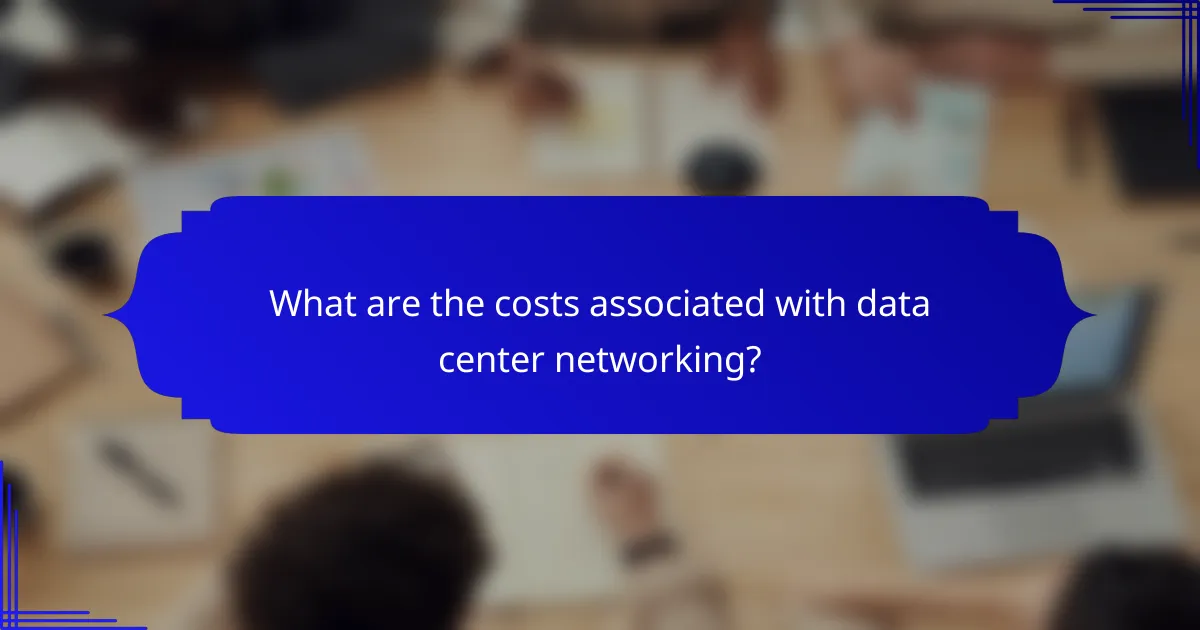
What are the costs associated with data center networking?
The costs associated with data center networking encompass initial setup expenses, ongoing operational costs, and potential savings strategies. Understanding these financial aspects is crucial for effective budgeting and resource allocation in data center management.
Initial setup costs
Initial setup costs for data center networking can vary significantly based on the scale and complexity of the infrastructure. Key expenses include hardware purchases, such as servers, switches, and routers, as well as installation and configuration services. Depending on the size of the data center, these costs can range from tens of thousands to several million dollars.
Additionally, factors like the choice of networking technology (e.g., fiber optics vs. copper cabling) and the need for specialized cooling systems can further influence initial expenditures. It’s essential to conduct a thorough cost analysis to ensure all potential expenses are accounted for.
Ongoing operational expenses
Ongoing operational expenses in data center networking primarily include power consumption, maintenance, and staffing costs. Power consumption is particularly significant, as networking equipment requires continuous electricity to function, often leading to monthly bills in the thousands of dollars, depending on the size of the facility and local energy rates.
Maintenance costs, including software updates and hardware repairs, should also be factored into the budget. Regular staffing for monitoring and managing the network infrastructure adds another layer of ongoing expense, which can vary based on the size of the team and their expertise.
Cost-saving strategies
Implementing cost-saving strategies can help mitigate the financial burden of data center networking. One effective approach is to optimize energy efficiency by investing in energy-efficient hardware and utilizing advanced cooling techniques, which can significantly reduce power consumption.
Additionally, consider leveraging virtualization technologies to maximize resource utilization, thereby decreasing the number of physical servers needed. Regularly reviewing service contracts and renegotiating with vendors can also lead to better pricing and terms, ultimately lowering operational costs.

What factors influence cooling system selection?
Cooling system selection for data centers is influenced by several key factors, including the size and layout of the facility, local climate conditions, and energy efficiency requirements. Understanding these elements helps in choosing an appropriate cooling solution that balances performance, cost, and sustainability.
Data center size and layout
The size and layout of a data center significantly affect cooling needs. Larger facilities may require more advanced cooling solutions, such as in-row cooling or chilled beams, to ensure uniform temperature distribution. Additionally, the arrangement of equipment can create hot spots that necessitate targeted cooling strategies.
For example, a data center with a high-density server configuration may need a more robust cooling system compared to a facility with lower density. Proper airflow management and strategic placement of cooling units can optimize efficiency and reduce operational costs.
Climate considerations in New Zealand
New Zealand’s climate plays a crucial role in cooling system selection for data centers. With varying temperatures and humidity levels across regions, cooling solutions must be tailored to local conditions. For instance, coastal areas may experience higher humidity, necessitating dehumidification in cooling systems.
Data centers in warmer regions may benefit from evaporative cooling systems, which can be more energy-efficient during summer months. It’s essential to consider local climate data when designing cooling systems to ensure optimal performance and compliance with energy efficiency standards.
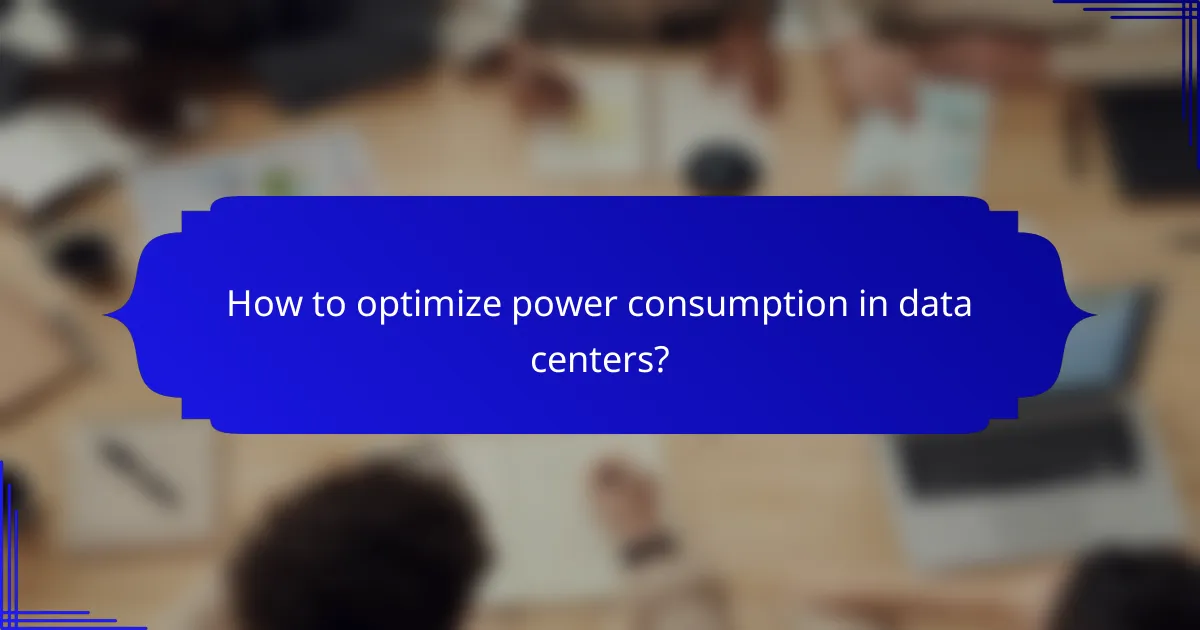
How to optimize power consumption in data centers?
To optimize power consumption in data centers, focus on implementing energy-efficient technologies, monitoring systems, and regular maintenance. These strategies can significantly reduce energy costs while maintaining performance and reliability.
Implementing energy management systems
Energy management systems (EMS) are crucial for tracking and optimizing power usage in data centers. By utilizing software that monitors energy consumption in real-time, facilities can identify inefficiencies and adjust operations accordingly. For example, integrating EMS can lead to energy savings of 10-30% depending on the existing infrastructure.
Consider adopting advanced technologies like machine learning algorithms that predict energy needs based on workload patterns. This proactive approach allows for dynamic adjustments, ensuring that power is used efficiently during peak and off-peak hours.
Regular maintenance practices
Regular maintenance is essential for ensuring that all equipment operates at peak efficiency, which directly impacts power consumption. Schedule routine checks on cooling systems, power supplies, and servers to identify and rectify issues before they escalate. Neglecting maintenance can lead to increased energy usage by 20-40% due to malfunctioning equipment.
Implement a checklist for maintenance tasks, including cleaning filters, checking for leaks, and ensuring proper airflow. These practices not only enhance energy efficiency but also prolong the lifespan of the equipment, reducing long-term costs.
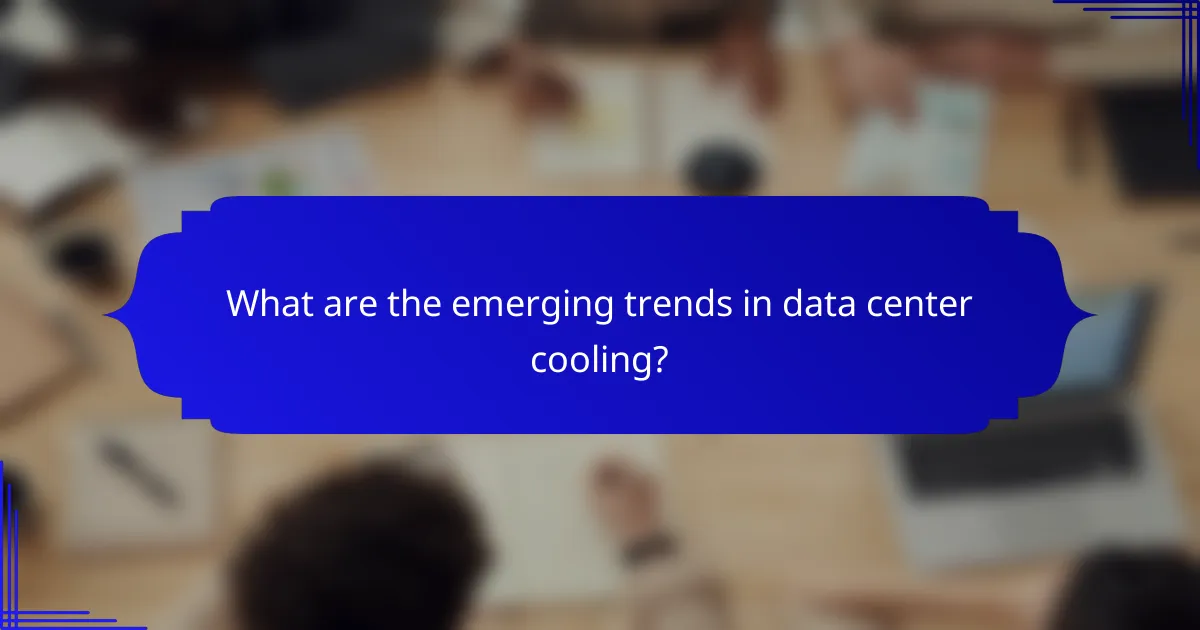
What are the emerging trends in data center cooling?
Emerging trends in data center cooling focus on enhancing efficiency and sustainability while managing rising power consumption. Innovations such as artificial intelligence and sustainable technologies are transforming traditional cooling methods, aiming to reduce costs and environmental impact.
Adoption of AI for cooling optimization
Artificial intelligence is increasingly being used to optimize cooling systems in data centers. By analyzing real-time data on temperature, humidity, and equipment performance, AI can adjust cooling outputs dynamically, ensuring that energy is used efficiently while maintaining optimal operating conditions.
Data centers can benefit from AI-driven predictive maintenance, which anticipates cooling system failures before they occur. This proactive approach minimizes downtime and reduces repair costs, ultimately leading to significant savings in operational expenses.
Trends in sustainable cooling technologies
Sustainable cooling technologies are gaining traction as data centers strive to lower their carbon footprints. Options such as liquid cooling and evaporative cooling systems are becoming more popular due to their ability to use less energy compared to traditional air conditioning methods.
Additionally, the integration of renewable energy sources, like solar or wind power, into cooling operations is on the rise. This not only reduces reliance on fossil fuels but can also lead to lower energy costs over time, making it a financially attractive option for data center operators.
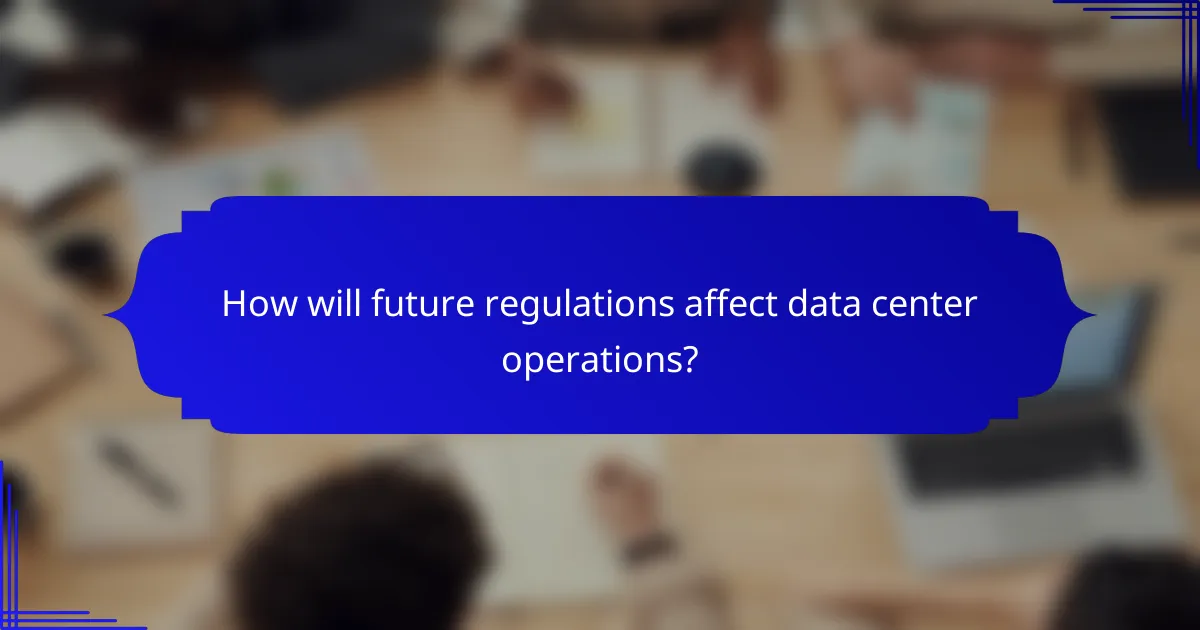
How will future regulations affect data center operations?
Future regulations will significantly impact data center operations by enforcing stricter energy efficiency and sustainability standards. These regulations aim to reduce power consumption and greenhouse gas emissions, compelling data centers to adopt more efficient technologies and practices.
Impact of energy efficiency regulations
Energy efficiency regulations will require data centers to optimize their power usage and cooling systems. This may involve implementing advanced cooling technologies, such as liquid cooling or free cooling, which can reduce energy consumption by significant margins. Data centers may also need to invest in energy-efficient hardware and software solutions to comply with these regulations.
For example, regulations may mandate that data centers achieve a Power Usage Effectiveness (PUE) of 1.2 or lower, which means that for every watt of power used by IT equipment, only a small amount is used for cooling and other overhead. Meeting such standards often requires upfront investment but can lead to long-term savings on energy costs.
Data center operators should stay informed about upcoming regulations and consider conducting energy audits to identify areas for improvement. Proactive measures, such as upgrading infrastructure and adopting renewable energy sources, can help ensure compliance and enhance operational efficiency.
